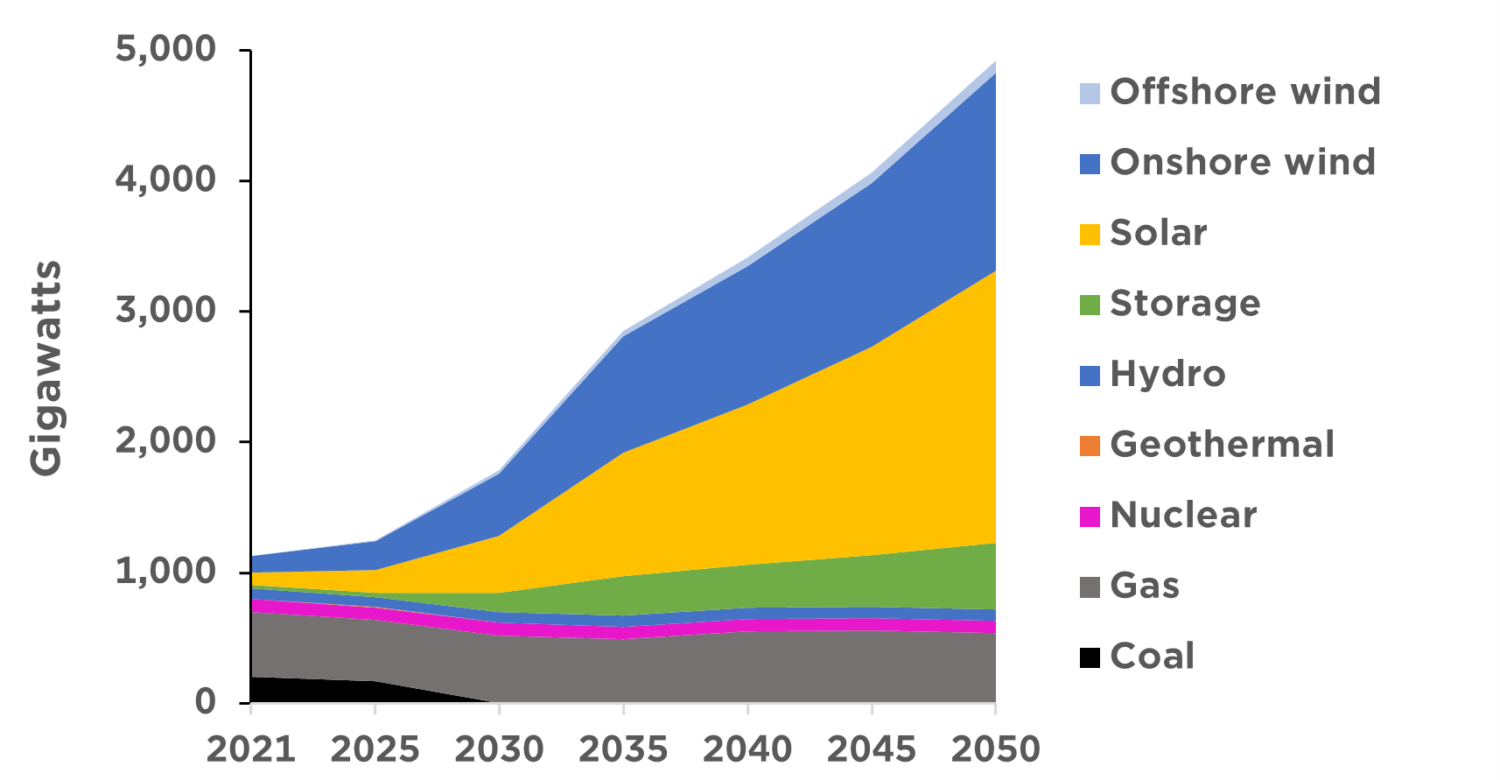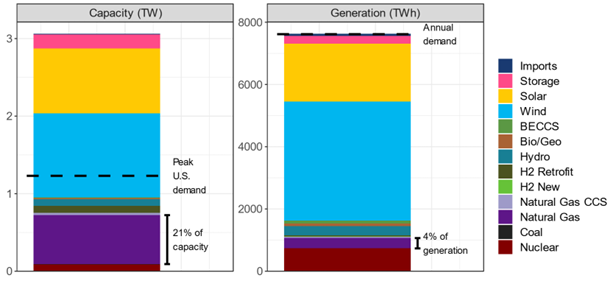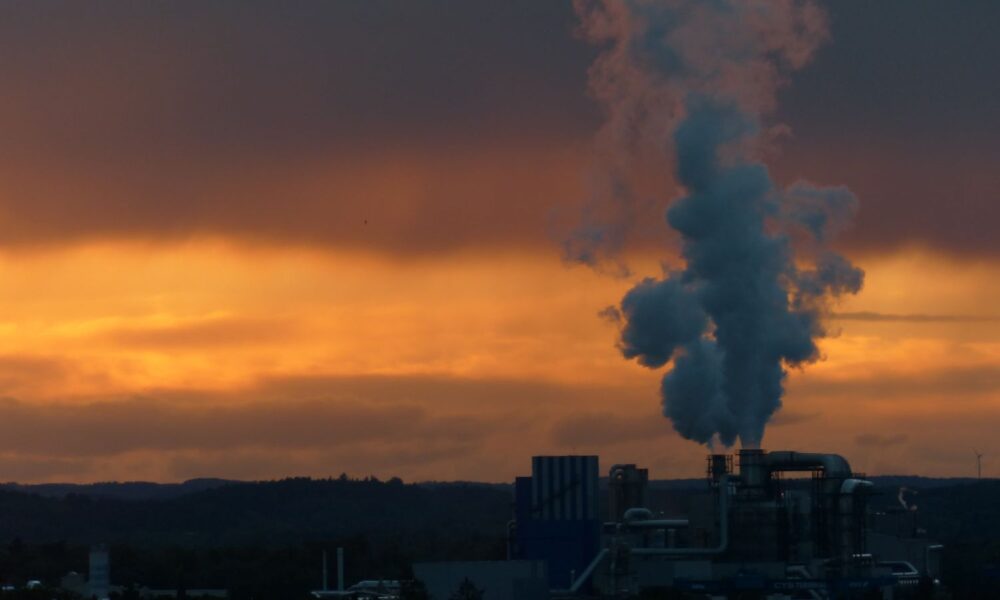Fossil gas power plants currently provide the largest source of electricity generation and capacity in the United States. To meet our climate goals and reach net zero emissions by 2050, most studies show that we need to dramatically reduce gas use for generating electricity, heating homes and businesses, and running industrial processes.
But gas power plants have also played an important role in helping to maintain the overall reliability of the electricity grid by meeting peak power demands, such as on hot summer days when people turn on their air conditioners. However, as we replace fossil fuels with clean electricity for heating and transportation to meet our climate goals, these peak demands will increasingly shift to the winter in many parts of the country. In addition, recent extreme weather events have shown that gas plants aren’t as reliable as utilities and grid operators have been assuming, especially during the winter. And this problem will only get worse as the impacts of climate change become more frequent and severe.
While it’s clear we need to rapidly reduce gas generation to help limit the worst impacts of climate change, it’s less clear how much fossil gas capacity we actually need to maintain reliability in a future decarbonized grid. It’s worth delving into because it has some important implications for our clean energy future.
Sharp reductions needed in gas generation to meet US climate goals
Under the Paris Agreement, the United States has committed to reducing heat-trapping emissions to 50-52 percent below 2005 levels by 2030 and to reaching net zero emissions no later than 2050. Recent UCS modeling, conducted in partnership with Evolved Energy Research (EER), shows that, to reach these goals means completely phasing out US coal generation by 2030; in this scenario, gas generation would fall from about 40 percent of US electricity generation in 2021 to 25 percent in 2030, and 2 percent in 2050 (see figure 1).
Figure 1. US Electricity Generation

Wind and solar lead the way in decarbonizing the power sector to meet near-term climate targets. Decarbonizing the power sector also plays a critical long-term role by replacing fossil fuels in other sectors. Source: UCS Accelerating Clean Energy Ambition.
In this plan, almost all of this coal and gas generation is replaced with wind and solar. Wind, solar, and other renewables nearly triple, from 22 percent of US electricity generation in 2021 to 60 percent in 2030 and continue to increase to 92 percent in 2050 under our Net Zero Pathway. The remaining 6 percent of US electricity generation that does not come from gas or renewables is projected to come from existing nuclear plants.
Most of the near-term deployment of wind and solar is driven by incentives in the Inflation Reduction Act (IRA) and existing state clean energy policies, as shown on the left of the graph. But after the IRA incentives expire in the early 2030s, we see gas and coal generation rebounding and US heat-trapping emissions flattening out. The exact impact of the IRA tax credits is uncertain and depends heavily on the rate at which wind, solar, energy storage, and transmission can be built over the next decade.
A very different role for gas in a decarbonized energy system
Our modeling shows that, while gas generation declines to de minimis levels by 2050 to meet US climate goals, gas capacity does not change much over time in order to help maintain reliability during periods of unusually low renewable generation (see figure 2). Some older gas and oil plants are replaced with more efficient plants during the near-term transition away from fossil fuels to wind and solar. A small amount of gas with carbon capture and storage (CCS) capacity (~10 gigawatts) is also added to help meet the 2030 emission reduction target and to take advantage of generous incentives for CCS in the IRA.
Figure 2. US Electric Generation Capacity under the Net Zero Pathway

While gas capacity stays relatively fixed over time, its share of total US electric capacity falls from 44 percent in 2021 to 11 percent in 2050 under the Net Zero Pathway, as electricity demand more than triples to replace fossil fuels with clean electricity in the transportation, buildings, and industrial sectors. Wind, solar, energy storage, and transmission provide the vast majority of new capacity additions, which demonstrates that these technologies play a significant and growing role in maintaining grid reliability in the future.
Importantly, though, overall use of that gas capacity dramatically declines over time. By 2050, gas plants operate at less than 6 percent of their rated capacity during the year compared to more than 38 percent for all gas plants in 2022, according to the Energy Information Administration (EIA).
These results are consistent with other decarbonization studies. For example, a 2023 National Renewable Energy Laboratory (NREL) study found that, to meet President Biden’s goal of achieving 100 percent clean electricity by 2035, gas generation would decline to 4 percent of US electricity generation but would provide 21 percent of total electricity capacity (see figure 3). (NREL also found that the emissions resulting from the remaining gas generation would be offset through the deployment of negative emissions technologies such as bioenergy with CCS and direct air capture with CCS).
Figure 3. US electricity capacity and generation under NREL’s All Options scenario in 2035

NREL’s modeling of reaching 100 percent clean electricity by 2035 shows a significant reduction in gas generation but maintains a significant dependence on gas capacity to provide peaking capacity and ensure resource adequacy during the clean energy transition. Source: NREL, 100% Clean Electricity by 2035 study.
Models overestimate the reliability of gas plants
While many grid modeling analyses examining a deeply decarbonized grid demonstrate a need to keep a large amount of gas capacity online, the catch is that most models overestimate the reliability of gas plants. These models often rely on methods adopted in regional electricity markets that don’t account for the systemic and widespread gas plant outages and other gas system failures that have occurred during extreme weather events fueled by climate change. While gas plant failures have been worse in the winter, problems have also occurred during the summer because of extreme heat and drought.
As highlighted in our recent Gas Malfunction report, these failures have led to rolling blackouts, which have caused serious health and safety consequences for communities left without power during critical times of need. It also means that gas plants have been overcompensated for their reliability services, putting other cleaner alternatives at an economic disadvantage and increasing costs to ratepayers. Gas plants failed disproportionately compared to other resource types in five extreme winter weather events, as shown in Figure 4.
Figure 4. Generation Failures by Fuel Type During Five Extreme Winter Storms

Gas plants accounted for most of the failed capacity in five recent extreme winter events. Gas plants failed disproportionately in comparison to gas’s percentage of total installed capacity, indicating they are more susceptible to extreme winter weather than other resource types. Source: UCS, Gas Malfunction
Recognizing the reliability threats gas power plants pose to the energy grid, a group of Regional Transmission Organizations (RTOs) recently published a joint position paper calling for improved gas-electric coordination.
Like other models, EER’s model assumes that, on average, 95 percent of a gas plant’s installed capacity is available to generate electricity at any given time and counts towards reliability. In industry parlance, this means it has an equivalent “forced outage rate” of 5 percent. NREL’s Regional Energy Deployment System (ReEDS) model is even more optimistic, assuming gas plants (and other conventional generators such as coal and nuclear) have a capacity credit of 100 percent.
Regional electricity markets that use similar numbers typically assume forced outages are completely independent of each other. This is a problem because such low forced outage rates don’t reflect the reality of gas plant performance during extreme weather. It also ignores the reality that gas power plant failures correlate with outages that occur in extreme weather. (For more details on how programs have been significantly overvaluing the reliability contributions of gas power plants, see this blog by my colleague Mark Specht).
A 2022 Astrape Consulting study that used probabilistic methods to account for the risks of correlated power plants outages found a capacity credit for gas (in PJM South) of 76 percent in winter and 85 percent in summer. And this North American Electric Reliability Corporation (NERC) report evaluating the impacts of the 2014 Polar Vortex shows forced outage rates for gas in January reached nearly 40 percent in some regions.
Reducing the reliability risks of an overreliance on gas
Fossil gas will certainly have a role to play in helping to meet peak demand even as we move to a decarbonized electricity grid. But the latest research and modeling suggests that it’s time to reassess how large a role that should be.
Nearly all grid modeling to date has assumed that gas plants are much more reliable than they actually are. We’ve started to see studies that shed light on how well gas plants perform, and they’re not meeting current expectations. So, we need to adjust our grid modeling to use realistic assumptions about gas plant contributions to grid reliability—both to ensure power system reliability and to make sure our modeling isn’t biased towards picking gas plants for grid reliability when they aren’t sufficiently performing that service.
One of the implications of this shift is that we need to consider alternatives to gas-fired plants that can reduce these risks and provide similar reliability services. While nuclear power, or gas with CCS could play a role providing these services, these technologies pose other significant cost, performance, and safety risks. Other cleaner and less risky alternatives—such as long-duration storage, geothermal energy, concentrating solar power with storage, and green hydrogen—could play an increasing role in meeting seasonal needs while also helping to address the performance issues gas plants have recently displayed during extreme weather events.

